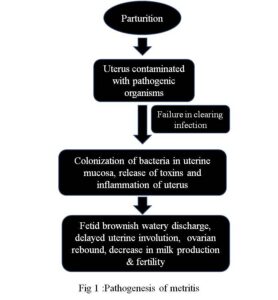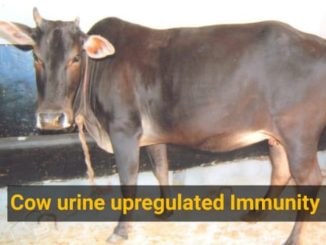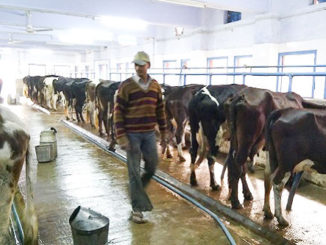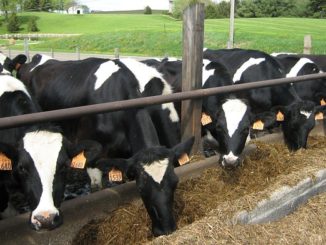Metritis is one of the most important economically important diseases in buffaloes that leads to a drastic reduction in milk yield, delay in uterine involution, ovarian rebound and severely affects the future fertility of the animals. Keeping the severity of the disease in mind, this manuscript aimed to summarize the disease process and how to effectively tackle the condition to prevent the enormous economic collapse of dairy farmers.
Introduction
Postpartum period is a crucial period for the dam’s health as she is most prone to many life-threatening disease conditions during this time. With parturition, the reproductive tract of dam becomes an easy entry point for infectious agents resulting in multiplication, colonization and onset of the disease process. This causes the animal’s health to deteriorate, which is reflected in the milk production and the health of the animal, resulting in a significant financial loss. Obstetrical manoeuvre during dystocia correction, retention of fetal membrane and poor hygienic conditions in calving area potentiates the disease process. Metritis is a life-threatening condition to dairy cattle as well as buffaloes and if prompt actions are not taken, chances of survival become a concern. Metritis is characterized by inflammation of all the three layers of uterus with an enlarged uterus containing a watery red-brown fluid to viscous off-white purulent uterine discharge, which often has a fetid odour and most commonly occurs within 10-15 days of calving. The severity of the infection is dependent on the degree of contamination, efficiency of the uterine defense mechanism and presence of substrates in the uterus which promotes the growth of the microbes such as devitalized tissues. Inflammation of the uterus delays the process of involution in the uterus and causes aberrations in the ovarian cycle leading to economic loss due to systemic illness, increased conception interval, increased number of inseminations, loss of milk and meat production and a marked drop in fertility. Metritis is one of the most important diseases that disrupt the reproductive performance of buffaloes and reduces livestock profitability.
Risk factors
Calving season: During rainy seasons, the general health of cows goes down making them more prone to uterine infections as the surrounding is contaminated by animal products and wastes. This provides a favourable opportunity for multiplication of the pathogenic bacteria and the pathogens can enter the reproductive organs at the time of parturition and causes serious uterine diseases like retained placenta, metritis and endometritis.
Nutrition: Nutrient availability plays a key role in the efficiency of the immune system. Cellular immunity is affected by protein quantity in food rations; deficiency in protein dramatically reduces cellular phagocytosis. However, excess protein intake induces high serum ammonia, that reduces lymphocyte production and potentiates the development of metritis and endometritis. Immune protective function is also facilitated by vitamins i.e., B and C, that have a role in antibody synthesis, and vitamin C, maintaining integrity of immune cell membranes and protects them from free radicals (reactive oxygen species). Vitamin A is involved in epithelial tissue development, regeneration and cell differentiation, which are no doubt important in the early postpartum stage. Thus, deficiency of vitamins during the postpartum period delays phagocytosis and promotes multiplication of pathogenic micro-organisms in the reproductive organs, and other tissues which in turn results in uterine diseases including clinical metritis and endometritis.
Parity: With age and parity, the incidence of uterine infection increases mainly due to injury occurred during repeated calving as well as loss of elasticity of uterus resulting in delayed uterine involution as compared to primiparous animals. Therefore, older buffaloes are more vulnerable to persistent uterine infections.
Dystocia: Dystocia is a serious risk factor that increases incidence of injury to reproductive tract which predisposes to colonization of pathogenic bacteria which is later on manifested by retained fetal membrane, metritis and endometritis. However, in a well-managed dairy herd the incidence of dystocia can be minimized.
Retained fetal membrane: Abortion, still birth, abnormal calving and premature birth can lead to failure of expulsion of fetal membrane. The remnant debris and necrotic tissue of placenta acts as a very good medium for bacterial growth, release of toxins and also hampers the uterine involution. Moreover, presence of residual tissue results in failure in closure of cervical canal which further increases introduction of bacteria in endometrium.
Metabolic stress: Failure of adequate calcium mobilization prior to calving results in hypocalcaemia. Since calcium is an important element in uterine involution, hypocalcemia induces reduced uterine contractions, causes dystocia, prolongs gestation and acts as potential risk factor for retained placenta occurrence subsequently development of metritis and endometritis occurrence.
Negative energy balance: A negative energy balance (NEB) is often linked with severe and prolonged uterine inflammation and delay in uterine involution, that appears to be associated with a lack of phagocytic activities of blood cells. NEB favours development of several metabolic disorders, primarily ketosis, that increases incidence of metritis, endometritis and retained placenta. A schematic diagram for the predisposing factors is shown in

Pathogenesis of metritis: After parturition, all the animals harbour bacterial contamination in reproductive tract with the potential to colonize and cause disease. Healthy animals are efficient to clear off bacterial load during the uterine cleansing process (boosted by strong maternal uterine health and innate immunity). However, some animals (under nourished, injury during parturition and weaker uterine defence mechanism) are unable to eliminate bacterial load which later on manifested in the form of metritis or endometritis (Figure 2).

Clinical signs
- Brownish watery, fetid discharge from uterus within 10-15 days of parturition with presence of debris and necrotic tissues
- Periodic straining
- May/ may not be coupled with fever (increased rectal temperature, which may reach upto 104-105° F)
- Symptoms of dehydration
- Toxaemia in untreated prolonged case
- In severe cases, cold extremities and collapse of animals
Diagnosis
- Based on the clinical signs and symptoms of fetid brown watery discharge, pyrexia and onset between 10-14 days of parturition, the case can be easily diagnosed
- Transrectal ultrasonography is of great value to evaluate the degree of fluid accumulation in uterus
- Uterine fluid can be collected for bacterial culture to identify the causative organism
Treatment
- Treatment of metritis depends on the severity of the disease. Cases with no systemic signs usually responds well with broad spectrum antibiotic treatment
- It is advisable to carry out antibiotic sensitivity test using the metritic uterine discharge to start treatment regime with the most effective antibiotic
- When the animal is dull with pyrexia coupled with periodic straining, supportive therapy with antipyretic drugs, fluid therapy and calcium supplementation is required.
- Calcium therapy helps in restoring myometrial contractibility
- Non-steroidal anti-inflammatory drugs such as flunixin meglumine is of great value in pyrexic conditions due to its anti-endotoxic effect
- Vitamin A, B complex and C are prescribed with the aim to improve immune function
- Intrauterine medicine administration is not out of danger as metritic uterus is very fragile with fluid load and can lead to rupture and peritonitis
Management
- Maintaining the optimum energy level in animals which are in advanced pregnancy so that negative energy balance condition after parturition can be minimized
- Maintaining sanitation and hygiene in calving sheds. Regular cleaning of shed as well as perineum of animal is required
- Provision of mineral mixtures in ration to be strictly followed as per international or national standards
- Calfhood vaccination at the age of 4 months of age with brucella vaccine as to minimize incidence of abortions, RFM and subsequently metritis
Conclusions
Metritis is a life-threatening condition for dam’s life and her productivity which is to be looked into from a managemental point of view rather than focusing on treatment-based cure. The condition can be effectively minimized by some minor modifications in our existing dairy farming system where we should stress more on transition cow management i.e., starting from 21 days before parturition till 21 days after parturition so to decrease the incidence of uterine infections in buffalo after parturition.
| The content of the articles are accurate and true to the best of the author’s knowledge. It is not meant to substitute for diagnosis, prognosis, treatment, prescription, or formal and individualized advice from a veterinary medical professional. Animals exhibiting signs and symptoms of distress should be seen by a veterinarian immediately. |






Be the first to comment